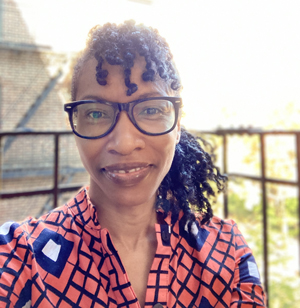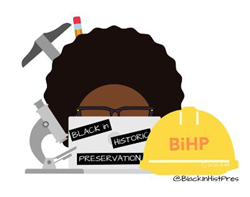K. Kennedy Whiters, Architect and Advocate for Equity in Historic Preservation, Queens, New York

K. Kennedy Whiters is owner and principal of kennedy Whiters + Associates, LLC. She received her Masters in Architecture and Masters of Urban Planning at the University of Illinois at Urbana-Champaign. Ms. Whiters is the founder of several historic preservation initiatives that support equitable practices in historic preservation: Black in Historic Preservation, Beyond Integrity in X, and unRedact the Facts. In preservation, the honors she has received in the field include a Mildred Colodny Scholarship from the National Trust for Historic Preservation in 2008, an Emerging Scholar Award from the Association for Preservation Technology International in 2011, and recognition by the Young Urban Preservationists of the Landmark Society of Western New York as one of eight “Women to Watch Today in Preservation and Design” in 2021.
What led you to your field?
A post-undergraduate experience in AmeriCorps on Chicago’s West Side. At the time, I was pre-med, planning to pursue family medicine to be of service to Black and Latinx majority neighborhoods. During the year of service, I was surrounded by beautiful buildings, gems, that society overshadowed with its negative perception of the people who inhabit and use the buildings - Black and Latinx people. This tension between perception and reality of place inspired me to be of service through architecture and historic preservation.
How does what you do relate to historic preservation?

I practice architecture and also owner’s representation/construction project management of historic buildings. I also provide education of equitable practices in historic preservation through Black in Historic Preservation, Beyond Integrity in (X), and unRedact the Facts—all initiatives that I began in the last 12 months. These initiatives are services I provide through my firm, kennedy Whiters + Associates, LLC . I am looking forward to hosting the inaugural Beyond Integrity in (X) Virtual Conference, Aug. 10-11, 2021. A conference I have been planning with my sponsors Culture of King County, WA, Historic Seattle, and Washington State Department of Archaeology and Historic Preservation, it will serve as an opportunity for attendees from across the continent to engage in conversations about the nominating and landmarking rules, ways to look beyond architectural integrity in the landmarking process on local, state, and national levels.
Why do you think historic preservation matters?
Inspiration for this response comes from Root Shock: How Tearing Up City Neighborhoods Hurts America, and What We Can Do About It by Dr. Mindy Fullilove, MD. Like our other animal counterparts, humans, whether we are aware of it or not, are connected to the environment. In particular, we are connected to the environment that we have shaped—the built environment. And, a highly regarded tool of historic preservation, the historic landmark/district, carries so much weight in the way our society perceives groups of people, neighborhoods, and is an instrumental tool that communities have used to leverage their social and financial power and influence. Heritage sites that become historic landmarks become members of the local/national archive—they are a part of our public memory as being significant to our existence. This designation communicates that the history that these places represent matters, and furthermore, that the people that these places represent, matter to our society, too. “Less than 8% of sites on the National Register are associated with women, Latinos, African Americans or other minorities,” according to ACHP Chairman-Nominee Sara Bronin in an LA Times article recently. And so, when landmark commissions and boards, designate heritage sites associated with wealthy, White people, while such a small percentage of designated sites are associated with White women and People of Color, what does this important act of designation, that has a ripple effect on the social and financial lives of these populations, say about the lives of these people? If their heritage does not matter for landmark designation, then what subtle message does this convey about their lives mattering, too?
What courses do you recommend for students interested in this field?
Land Use Law, Real Estate Development, Nonprofit Management, Introduction to Reading Architectural Drawings, Technical/Business Writing, Project Management, Business Courses such as Marketing and Financial Management, and Ethics. Think about your career with the expected salary and job prospects in mind. A historic preservation degree or certificate alone produces fewer employment and salary opportunities than say a degree in architecture, urban planning, or law paired with a concentration, certificate, or degree in historic preservation.
Do you have a favorite preservation project? What about it made it special?
So many. A project I did not work on, but so glad the mayor’s wife stepped in to support public advocacy to save it in the 1960s - the Chicago Cultural Center. Completed in 1897 by construction crews, it’s the former central library, this city’s first, and rightly dubbed the “People’s Palace.” Slated for demolition in the mid-1960s, Landmarks Illinois, the Chicago Heritage Committee, and Eleanor “Sis” Daley, wife to then-Mayor Richard J. Daley, were among the many who successfully advocated for its protection. The Cultural Center’s preservation was rare at a time when the city, like so many across the country, was demolishing gems in the name of modernization and progress. The building is so full of life and love, from the art galleries on the first floor, to the city’ Department of Cultural Affairs on the upper floors, and what I view as the city’s indoor living room where one would find people of all socioeconomic backgrounds reading, eating, and meeting—it really is the People’s Palace and a landmark example of the power of preservation.
Can you tell us what you are working on right now?
Advocating for individuals and institutions to use the active voice when re-telling US history to tell a fuller story for racial equity. Generally speaking, our educational systems train us to use the passive voice because it is “professional writing.” However, this form of professional writing omits or redacts portions of our history, the uncomfortable parts and the parts that tell a fuller story about the humanity and intelligence of non-White people. These omissions and more do not serve us if we say we want a more progressive, diverse society or field. They, in fact, perpetuate lies about the past. And, we deserve better - we deserve an unredacted history that tells the fuller story for racial equity.
How do you think the national historic preservation programs help your community?
National historic preservation programs help communities by providing guidance to local agencies, students, tradespeople, and practitioners on best practices for historic preservation. I’m glad the national guidance exists—some of my favorite preservation resources are the Technical Briefs published by the National Park Service. While they help communities by setting guidelines, many of the guidelines lack the nuisance necessary for an equitable practice of historic preservation. I’m thankful for individuals and institutions across the country who are addressing these deficiencies in their own preservation practices.
Do you have advice for novice preservationists?
Learn about the importance of ethics in the practice of historic preservation. However, the onus is not just on the novice preservationist I encourage preservation and architecture schools and other education outlets to offer courses in ethics. When you write landmark nomination forms, give as much if not more attention to the cultural significance of a place, and when you write the statement of significance, use the active voice. There is power in your written word - landmark boards and commissions rely on what you write in these nomination forms when they decide to nominate and designate heritage resources.
The ACHP’s mission is “preserving America’s heritage;” can you give us an example of how your community is preserving its heritage?
I’m in awe of the preservation work of many Black and Latinx people across the country. Recently, I went on a neighborhood tour of East Brooklyn, NY led by Zulmilena Then. Through her nonprofit Preserving East New York Zulmilena and her team highlight and advocate for the architectural gems in her neighborhood. They do this by bringing an awareness of these gems to her immediate East Brooklyn community and to members of the community at-large, like me. Dr. Tiffany Momon and her team at the Black Craftspeople Digital Archive are preserving the heritage of Black people in the United States through archival research in the form of maps and databases that tell a fuller story of early Black Americans, one that includes their history as not just the property of White people, but as skilled craftspeople.
Why is it important to you that historic preservation become a more diverse and progressive field?
Up until the last 20 or so years (focus on the “or so” - can’t be too sure on the flex point for the change), the field has been majority wealthy, cis-hetero, female, able-bodied, and White in numbers and thinking. Therefore, the retelling and interpretation of history has reflected the perspective of those with social and financial power and power in numbers. It is important that historic preservation becomes a more diverse and progressive field because the nation it represents is diverse and has a diverse, rich history that deserves preservation. Plus, being a diverse and progressive field benefits us all.
Read more Q&A stories about the Preservationists in Your Neighborhood!